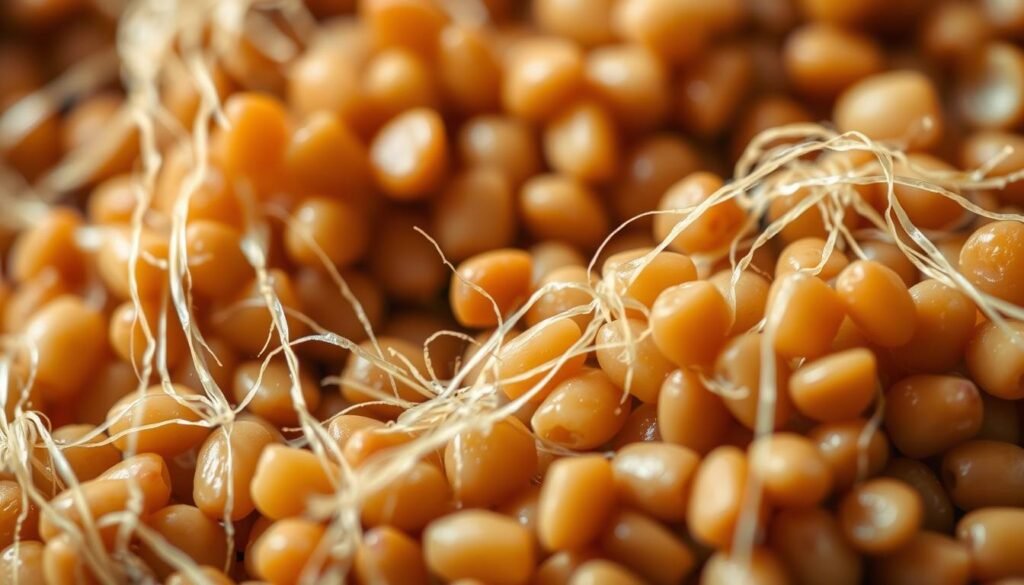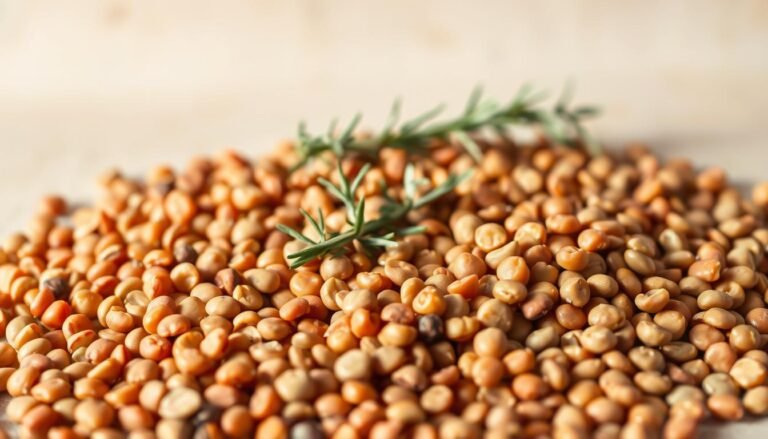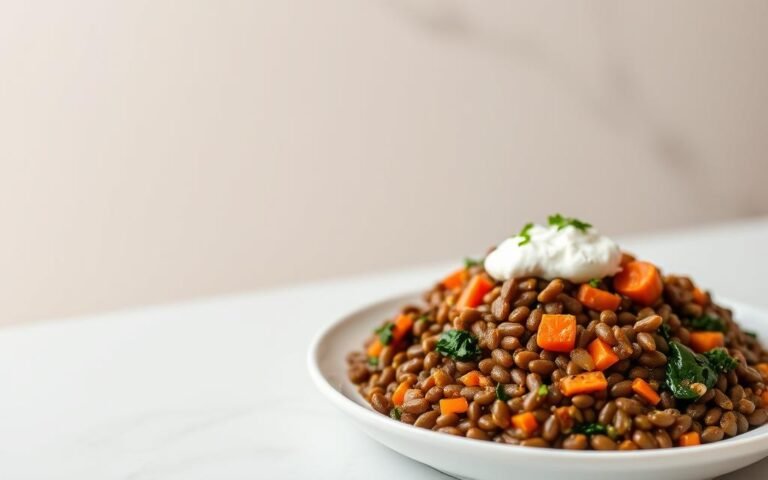Lentils are a nutrient-dense food that offers numerous health benefits, making them an excellent addition to a healthy diet. One of their key advantages is their high content of dietary fiber, which plays a crucial role in promoting healthy digestion and supporting weight management.
One cup of cooked lentils contains a significant amount of fiber, approximately 16 grams. This high fiber content helps regulate bowel movements, preventing constipation and supporting healthy blood sugar levels.
Key Takeaways
- Lentils are rich in dietary fiber, supporting healthy digestion.
- A high-fiber diet can help regulate blood sugar levels.
- Including cooked lentils in your diet can promote overall gut health.
- Lentils are a nutrient-dense food, offering numerous health benefits.
- A diet rich in fiber can support weight management.
The Nutritional Powerhouse of Lentils
Lentils are not only a good source of protein but also rich in fiber, iron, and polyphenols, making them a nutritional powerhouse. They deliver approximately 18% of the Daily Value for protein, making them an excellent plant-based alternative for those looking to boost their protein intake. As a gut health food, lentils support digestive well-being and overall health.
Key Nutrients Found in Lentils
Lentils are rich in essential nutrients, including:
- Protein: approximately 18% of the Daily Value
- Fiber: supporting healthy digestion and bowel movements
- Iron: crucial for healthy red blood cells
- Polyphenols: antioxidants that help protect against cell damage
These nutrients work together to provide numerous health benefits, from supporting heart health to aiding in the management of blood sugar levels.
Lentils as a Staple in Global and Australian Cuisines
Lentils have been a staple ingredient in many cuisines around the world, including Australian cuisine. They are versatile and can be incorporated into a variety of dishes, from soups and stews to salads and curries. In Australian cuisine, lentils are often paired with local produce, such as vegetables and meats, to create hearty and nutritious meals.
The inclusion of lentils in Australian diets not only enhances the nutritional quality of meals but also supports sustainable eating practices, as lentils are a low-impact crop.
The Fiber in Cooked Lentils: Types and Amounts
Lentils, when cooked, become a powerhouse of fiber, contributing to better digestive health and more stable blood sugar levels. The fiber in cooked lentils is a critical component of a healthy diet, particularly for individuals looking to manage their blood sugar levels and improve their overall digestive health.

Soluble vs. Insoluble Fiber Content
Cooked lentils contain both soluble and insoluble fiber, each playing a unique role in maintaining health. Soluble fiber dissolves in water, forming a gel-like substance that helps slow down the absorption of sugar into the bloodstream, thereby regulating blood sugar levels. On the other hand, insoluble fiber adds bulk to stool, promoting regular bowel movements and preventing constipation.
The balance between soluble and insoluble fiber in cooked lentils makes them an ideal food for supporting digestive health and managing blood sugar levels. Consuming a mix of both types of fiber is essential for maximizing these benefits.
How Cooking Affects Fiber Content in Lentils
The method and duration of cooking can significantly impact the fiber content in lentils. While cooking makes lentils more digestible, overcooking can lead to a loss of some of the fiber, particularly the soluble kind. It’s essential to cook lentils just until they’re tender to preserve their fiber content.
Soaking lentils before cooking can also help reduce cooking time and may help retain more of the fiber content. However, the impact of soaking on fiber content can vary depending on the soaking time and method.
Understanding how cooking affects the fiber in lentils can help individuals prepare lentils in a way that maximizes their nutritional benefits, including their positive impact on blood sugar levels and digestive health.
How Lentil Fiber Supports Digestive Health
The fiber in cooked lentils plays a crucial role in maintaining a healthy digestive system. Lentils are rich in dietary fiber, which is essential for promoting regular bowel movements and preventing constipation. This makes them an excellent addition to a diet focused on improving digestive health.
Promoting Regular Bowel Movements
The fiber content in lentils helps to add bulk to stool and soften it, making it easier to pass. This can help prevent constipation and reduce the risk of developing hemorrhoids and diverticulitis. Regular bowel movements are crucial for removing toxins from the body, and lentil fiber supports this process.
Feeding Beneficial Gut Bacteria
Lentil fiber acts as a prebiotic, feeding the beneficial bacteria in the gut. This helps to promote a healthy gut microbiome, which is essential for overall health. A balanced gut microbiome supports the immune system, produces certain vitamins, and aids in the digestion of food.
Reducing Inflammation in the Digestive Tract
The fiber in lentils can also help reduce inflammation in the digestive tract. This is important because chronic inflammation can lead to various digestive disorders. By reducing inflammation, lentil fiber contributes to a healthier digestive system.
Preventing Digestive Disorders
A diet rich in fiber from lentils can help prevent digestive disorders such as irritable bowel syndrome (IBS) and diverticular disease. The fiber helps to regulate bowel movements and reduce pressure on the digestive tract, thereby preventing these conditions.
Incorporating cooked lentils into your diet can have a significant positive impact on your digestive health. With their high fiber content, lentils support regular bowel movements, a healthy gut microbiome, and reduced inflammation in the digestive tract.
Lentils and Blood Sugar Regulation
The role of lentils in blood sugar regulation is gaining attention, thanks to their rich fiber content and low glycemic index. Lentils are a nutrient-dense food that can play a crucial role in managing blood sugar levels.
The Low Glycemic Index of Lentils
Lentils have a low glycemic index (GI), which means they are digested slowly, causing a gradual and minimal increase in blood sugar levels. This characteristic makes lentils an excellent food choice for those monitoring their blood sugar.
How Fiber Slows Sugar Absorption
The fiber in lentils not only contributes to their low GI but also slows down the absorption of sugar into the bloodstream. This slowing of sugar absorption helps in maintaining stable blood sugar levels.

Research on Lentils and Insulin Sensitivity
Studies have shown that incorporating lentils into one’s diet can improve insulin sensitivity. Improved insulin sensitivity means that the body can more effectively use insulin, thereby regulating blood sugar levels more efficiently.
Benefits for People with Diabetes or Prediabetes
For individuals with diabetes or prediabetes, lentils can be particularly beneficial. Replacing half a serving of rice with lentils has been shown to reduce blood glucose by 20%. This dietary adjustment can be a simple yet effective strategy for managing blood sugar levels.
| Benefit | Description |
|---|---|
| Low Glycemic Index | Lentils are digested slowly, minimizing spikes in blood sugar. |
| Fiber Content | Slows down sugar absorption, aiding in stable blood sugar levels. |
| Improved Insulin Sensitivity | Lentils can enhance the body’s response to insulin. |
Incorporating lentils into a balanced diet can be a valuable step towards better blood sugar regulation. With their rich nutritional profile and versatility in cooking, lentils offer a delicious and healthy solution for those looking to manage their blood sugar levels effectively.
Different Types of Lentils and Their Fiber Content
From red to green, and brown to black, lentils vary not just in color but also in fiber content. This diversity allows consumers to choose the type that best suits their nutritional needs and culinary preferences.
Red Lentils vs. Green Lentils
Red lentils and green lentils are two of the most commonly consumed varieties. Red lentils tend to have a slightly lower fiber content compared to their green counterparts. For instance, red lentils typically contain around 10-11 grams of fiber per 100 grams when cooked, while green lentils can have up to 12 grams per 100 grams cooked. The difference is partly due to the processing and the skin thickness of the lentils.
Brown, Black, and Yellow Varieties
Beyond red and green, there are other varieties such as brown, black, and yellow lentils, each with its own fiber content. Brown lentils are known for their earthy flavor and hold their shape well after cooking, with a fiber content similar to green lentils. Black lentils, also known as beluga lentils, have a slightly higher fiber content and are prized for their ability to retain their texture. Yellow lentils are less common but still offer a good amount of fiber.
Which Lentils Pack the Most Fiber Punch
Among the various types, black lentils generally have one of the highest fiber contents. According to nutritional data, 100 grams of cooked black lentils can contain approximately 13-14 grams of fiber. For those looking to maximize their fiber intake from lentils, black or green lentils are good choices.
Lentil Varieties Available in Australian Markets
In Australian markets, consumers can commonly find red, green, and brown lentils. According to a report by Country Life Foods, there is a growing availability of black and other specialty lentils in larger supermarkets and health food stores. This variety allows Australians to experiment with different types and maximize their intake of fiber in cooked lentils.
As nutritionist Dr. Jane Smith once said, “Incorporating a variety of lentils into your diet can significantly boost your fiber intake, supporting digestive health and satiety.” This highlights the importance of having access to different lentil varieties.
Optimal Cooking Methods to Preserve Fiber in Lentils
To maximize the nutritional benefits of lentils, particularly their fiber, it’s essential to employ the right cooking techniques. Lentils are a rich source of dietary fiber, which plays a crucial role in digestive health and blood sugar regulation.
Soaking: Necessary or Not?
Soaking lentils can reduce cooking time and may help in removing some antinutrients. However, it’s not strictly necessary for preserving fiber. If you choose to soak, a short soak of 30 minutes can be beneficial. For those short on time, cooking without soaking is also effective.
Cooking Times and Techniques
Cooking lentils until they are tender is key. Overcooking can break down some of the fiber, so it’s best to cook them until they are just tender. Using a gentle simmer rather than a vigorous boil can help preserve the fiber content.
Using Pressure Cookers and Slow Cookers
Pressure cookers can significantly reduce cooking time, which can help preserve the fiber in lentils. Slow cookers, on the other hand, allow for a hands-off approach and can cook lentils thoroughly without overcooking, thus maintaining their fiber content.
Common Cooking Mistakes to Avoid
One common mistake is overcooking lentils, which can lead to a loss of fiber. Another is not adjusting cooking times based on the type of lentil being used. Red lentils, for example, cook much faster than green or brown lentils.
By adopting these cooking methods, you can enjoy lentils that are not only delicious but also rich in fiber, supporting your overall health and wellbeing.
Incorporating Lentils into Your Australian Diet
Lentils are a versatile ingredient that can be easily incorporated into various Australian dishes, from hearty soups to fresh salads. The Australian diet can greatly benefit from the inclusion of lentils due to their high nutritional value.
Lentil Recipes with an Aussie Twist
Australian cuisine offers a unique blend of flavors and ingredients that can be combined with lentils to create delicious and nutritious meals. For example, a lentil and bush tomato stew or a salad featuring lentils, grilled kangaroo, and native greens can be a great way to incorporate lentils into your diet.
Some other ideas include lentil and avocado toast, lentil curry with Australian vegetables, or a hearty lentil and vegetable soup.
Pairing Lentils with Local Australian Produce
Australia is renowned for its fresh and diverse produce. Pairing lentils with local ingredients not only enhances the flavor but also increases the nutritional value of meals. For instance, combining lentils with leafy greens like kale or spinach, and adding some native herbs like lemon myrtle, can create a nutrient-dense dish.
Meal Prep Ideas for Busy Australians
For busy Australians, meal prep is a convenient way to ensure healthy eating. Lentils can be a great addition to meal prep due to their ease of cooking and versatility. Ideas include cooking a large batch of lentils and using them in different meals throughout the week, such as lentil salads, lentil soups, or as a protein source in curries.
Australian Nutritionists’ Recommendations on Lentil Consumption
Australian nutritionists recommend incorporating lentils into the diet at least 2-3 times a week. They highlight the benefits of lentils in managing blood sugar levels and promoting digestive health. Nutritionists also suggest combining lentils with other whole grains and vegetables for a balanced meal.
| Lentil Type | Cooking Time | Nutritional Highlights |
|---|---|---|
| Red Lentils | 20-25 minutes | High in fiber, protein, and minerals |
| Green Lentils | 30-35 minutes | Rich in iron, potassium, and fiber |
| Brown Lentils | 30-40 minutes | Good source of fiber, protein, and antioxidants |
Potential Side Effects and Considerations
Incorporating lentils into your meals can have numerous health benefits, but it’s essential to be aware of potential drawbacks. While lentils are a nutritious addition to a balanced diet, some individuals may experience side effects, particularly during the initial adjustment period.
Digestive Adjustment Period
When you start consuming lentils, your digestive system may need some time to adjust. This adjustment period can involve bloating, gas, or discomfort. Gradually introducing lentils into your diet can help minimize these effects.
Antinutrients in Lentils and How to Reduce Them
Lentils contain antinutrients like phytic acid, which can impair nutrient absorption. Soaking, sprouting, or cooking lentils can help reduce these compounds. For example, soaking lentils overnight before cooking can significantly decrease phytic acid levels.
| Method | Effect on Phytic Acid |
|---|---|
| Soaking | Reduces phytic acid by up to 50% |
| Cooking | Further reduces phytic acid levels |
| Sprouting | Activates enzymes that break down phytic acid |
Who Should Exercise Caution with High-Fiber Lentils
Individuals with certain health conditions, such as irritable bowel syndrome (IBS), should be cautious when consuming high-fiber foods like lentils. It’s advisable to consult with a healthcare provider or a dietitian to determine the best approach for your specific needs.
Conclusion: Making Lentils a Regular Part of Your Healthy Diet
Incorporating lentils into a healthy diet can have numerous benefits, from supporting digestive health to regulating blood sugar levels. The fiber in cooked lentils plays a significant role in these benefits, making them an excellent addition to meals.
Lentils and blood sugar regulation are closely linked, as the soluble fiber in lentils slows down the absorption of sugar into the bloodstream, helping to manage blood sugar levels. This makes lentils particularly beneficial for individuals with diabetes or prediabetes.
To make lentils a regular part of your diet, try incorporating them into your meals in various forms, such as soups, stews, or salads. Australian cuisine offers a wide range of local produce that pairs well with lentils, making it easy to create delicious and healthy dishes.
By including lentils in your diet, you can take advantage of their nutritional benefits, supporting overall health and wellbeing. With their versatility and nutritional value, lentils are an excellent choice for those looking to enhance their diet.





